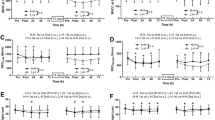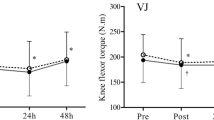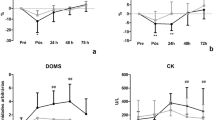Abstract
This study was aimed to analyze the loss of muscle explosive force in the early phase of eccentric exercise-induced damage, and its possible relationships with muscle soreness and blood creatine kinase (CK) levels. Squat jump (SJ) and counter-movement jump (CMJ) heights decreased in response to an eccentric exercise (120 eccentric actions of the knee extensors), with reductions that persisted at least for 24 h. The SJ/CMJ ratio was not significantly modified. Blood CK levels changed significantly over time and CK activity was significantly higher at 6 and at 24 h when compared to values obtained immediately after the eccentric exercise. Muscle soreness perceived at 6 h was slightly higher than that experienced just after finalizing the exercise and reached a clearly upper value at 24 h. A highly significant relationship between SJ and CMJ height loss was observed. CK activity at 24 h was significantly related to the SJ height loss at 6 h and to both the SJ height loss and the CMJ height loss immediately after the exercise. In summary, eccentric exercise induced a reduction in the explosive force generating capacity that affected in a similar way the pure concentric jump (SJ) and the jump eliciting the stretch-shortening cycle (CMJ). Results obtained suggest that CK activity is a better predictor of explosive force reduction than soreness, at least when values close to the peak are used.
Resumen
En el presente estudio se analiza la pérdida de fuerza explosiva en la fase temprana del daño inducido por un ejercicio excéntrico, y su posible relación con el dolor muscular y los niveles plasmáticos de creatina quinasa (CK). La altura de salto, tanto estático (SJ) como reactivo (CMJ), disminuyó en respuesta al ejercicio excéntrico (120 contracciones excéntricas de los extensores de la rodilla), con reducciones que persistieron durante al menos 24 h. La relación SJ/CMJ no experimentó modificación alguna. Los niveles plasmáticos de CK cambiaron significativamente a lo largo del tiempo, siendo mayores a las 6 y a las 24 horas que al finalizar el ejercicio excéntrico. El dolor muscular percibido a las 6 horas fue significativamente mayor que el experimentado justo al finalizar el ejercicio y alcanzó un valor claramente superior a las 24 h. Se observó una alta correlación entre la pérdida de altura de SJ y la pérdida de altura CMJ. La concentración plasmática de CK a las 24 h mostró una correlación significativa con la pérdida de altura SJ a las 6 h, así como con la pérdida de altura SJ y CMJ inmediatamente después del ejercicio. En resumen, el ejercicio excéntrico indujo una reducción en la capacidad del músculo de generar fuerza de forma explosiva, que afectó en igual medida al salto concéntrico puro (SJ) y al salto que incluye ciclo, estiramiento-acortamiento (CMJ). Los resultados obtenidos sugieren que la concentración plasmática de CK predice mejor la reducción de fuerza explosiva inducida por el ejercicio excéntrico que el dolor muscular, principalmente cuando se usan valores cercanos al pico.
Similar content being viewed by others
References
Abbot, B.C., Bigland, B., and Ritchie, J.M. (1952):J. Physiol.,117, 380–390.
Armstrong, R.B., Ogilvie, R.W., and Schwane, J.A. (1983):J. Appl. Physiol.,54, 80–93.
Balnave, C.D., and Allen, D.G. (1995):J. Physiol.,488, 25–36.
Brown, S.J., Child, R.B., Donnelly, A.E., Saxton, J.M., and Day, S.H. (1996):Eur. J. Appl. Physiol. Occup. Physiol.,72, 515–521.
Cavagna, G.A., Saibene, F.P., and Margaria, R. (1965):J. Appl. Physiol.,20, 157–158.
Clarkson, P.M., and Ebbeling, C. (1988):Clin. Sci.,75, 257–261.
Clarkson, P.M., Nosaka, K., and Braun, B. (1992):Med. Sci. Sports Exerc.,24, 512–520.
Fridén, J., and Lieber, R. L. (2001):Acta Physiol. Scand.,171, 321–326.
Fridén, J., Sjostrom, M., and Ekblom, B. (1983):Int. J. Sports Med.,4, 170–176.
Harrison, A.J., and Gaffney, S.D. (2004):J. Strength Cond. Res.,18, 771–776.
Howell, J.N., Chleboun, G., and Conatser, R. (1993),J. Physiol.,464, 183–196.
Kawakami, Y., Muraoka, T., Ito, S., Kanehisa, H., and Fukunaga, T. (2002):J. Physiol.,540, 635–646.
MacIntyre, D.L., Reid, W.D., Lyster, D.M., Szasz, I.J. and McKenzie, D.C. (1996):J. Appl. Physiol.,80, 1006–1013.
McHugh, M.P., Connolly, D.A., Eston, R.G., and Gleim, G.W. (2000):J. Sports. Sci.,18, 163–172.
Michaut, A., Pousson, M., Ballay, Y., and Van Hoecke, J. (2001):Eur. J. Appl. Physiol.,84, 569–574.
Morgan, D.L., and Allen, D.G. (1999):J. Appl. Physiol.,87, 2007–2015.
Newham, D.J., Jones, D.A., and Clarkson, P.M. (1987):J. Appl. Physiol.,63, 1381–1386.
Newham, D.J., McPhail, G., Mills, K.R., and Edwars, R.H. (1983):J. Neurol. Sci.,61, 109–122.
Price, D.D., McGrath, P.A., Rafii, A., and Buckingham, B. (1983):Pain,17, 45–56.
Reeves, N.D., and Narici, M.V. (2003):J. Appl. Physiol.,95, 1090–1096.
Rodenburg, J.B., Bar, P.R., and De Boer, R. W. (1993):J. Appl. Physiol.,74, 2976–2983.
Smith, L.L. (1991):Med. Sci. Sports Exerc.,23, 542–551.
Takekura, H., Fujinami, N., Nishiwaza, T., Ogasawara, H., and Kasuga, N. (2001):J. Physiol.,533, 571–583.
Teague, B.N., and Schwane, J.A. (1995):Med. Sci. Sports Exerc.,27, 1378–1384.
Thomas, M., Fiatarone, M.A., and Fielding, R.A. (1996):Med. Sci. Sports Exerc.,28, 1321–1326.
Tiidus, P.M., and Ianuzzo, C.D. (1983):Med. Sci. Sports Exerc.,15, 461–465
Warren, G.L., Lowe, D.A., and Armstrong, R.B. (1999):Sports Med.,27, 43–59.
Yuhasz, M.S. (1974):Physical Fitness Manual. London, Canada: University of Western Ontario.
Author information
Authors and Affiliations
Corresponding author
Rights and permissions
About this article
Cite this article
García-López, D., de Paz, J.A., Jiménez-Jiménez, R. et al. Early explosive force reduction associated with exercise-induced muscle damage. J. Physiol. Biochem. 62, 163–169 (2006). https://doi.org/10.1007/BF03168465
Received:
Issue Date:
DOI: https://doi.org/10.1007/BF03168465




